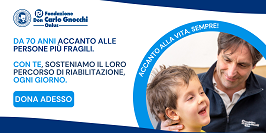Databases
Services
Submit
Restricted area
ATOM - Assistive Technology Outcome Measurement
Record number: 512
Last update: September 2022
Type of document: Projects
Last update: September 2022
Type of document: Projects
Funding body: Ministero della Salute
Partners: Fondazione Don Carlo Gnocchi ONLUS
Year of publication: 2016
Project start date: 01/01/2016
Project end date: 31/12/2017
Project state: Ended
F.d.G. Team: CITT (Centro Innovazione e Trasferimento Tecnologico) in collaborazione con il Servizio DAT (Domotica, Ausili e Terapia Occupazionale) e con i servizi ausili degli altri Centri della Fondazione
Abstract:
Study funded by the Ministry of Health in the field of Current Research IRCCS. The measure of the outcome, as a verification of the real effectiveness of the prosthetic intervention with respect to the established objectives and the user’s perception, must be carried out on site after a reasonable time of use of such assistive devices or facilitators in the usual living environment. This is particularly important in the Don Gnocchi Foundation Centres, given the high percentage of users who receive, during visits or rehabilitation treatments, indications or prescriptions of assistive devices to be used for daily autonomy, often of significant economic, personal and family impact. The acquisition of such assistive devices - and, where possible, the supply at the expense of the SSN - happens, however, when the user has already been discharged from treatment; it is therefore very difficult to control the correct implementation, only the presumed effects of the intervention are known (those measured at discharge), not the true outcome, which can only be measured at a reasonable distance of time in the real life environment. This research aims to fill this gap by introducing a systematic follow-up method for measuring the outcome of prosthetic interventions, applicable to all assistive devices and environmental adaptations, suitable to be implemented in the rehabilitation paths, both in the Don Gnocchi Foundation Centers but potentially also in any other structures of the National Health Service or accredited by it. It aims to measure the effectiveness of the intervention compared to the objectives set in the rehabilitation project and the perceived utility of the user, to estimate the relationship between costs incurred and results achieved, and to detect any critical issues that require corrective actions (technical interventions, instructions, counselling, revaluation of aids due to changed clinical conditions, etc.). It is assumed that this method should include a home visit for each user where an operator administers questionnaires and makes observations; the possibility for a lighter method is also presumed in case of impossibility of on-the-spot inspection, with appropriate means of collecting data at a distance that nevertheless allow sufficient estimates and detection of any critical issues.
Study funded by the Ministry of Health in the field of Current Research IRCCS. The measure of the outcome, as a verification of the real effectiveness of the prosthetic intervention with respect to the established objectives and the user’s perception, must be carried out on site after a reasonable time of use of such assistive devices or facilitators in the usual living environment. This is particularly important in the Don Gnocchi Foundation Centres, given the high percentage of users who receive, during visits or rehabilitation treatments, indications or prescriptions of assistive devices to be used for daily autonomy, often of significant economic, personal and family impact. The acquisition of such assistive devices - and, where possible, the supply at the expense of the SSN - happens, however, when the user has already been discharged from treatment; it is therefore very difficult to control the correct implementation, only the presumed effects of the intervention are known (those measured at discharge), not the true outcome, which can only be measured at a reasonable distance of time in the real life environment. This research aims to fill this gap by introducing a systematic follow-up method for measuring the outcome of prosthetic interventions, applicable to all assistive devices and environmental adaptations, suitable to be implemented in the rehabilitation paths, both in the Don Gnocchi Foundation Centers but potentially also in any other structures of the National Health Service or accredited by it. It aims to measure the effectiveness of the intervention compared to the objectives set in the rehabilitation project and the perceived utility of the user, to estimate the relationship between costs incurred and results achieved, and to detect any critical issues that require corrective actions (technical interventions, instructions, counselling, revaluation of aids due to changed clinical conditions, etc.). It is assumed that this method should include a home visit for each user where an operator administers questionnaires and makes observations; the possibility for a lighter method is also presumed in case of impossibility of on-the-spot inspection, with appropriate means of collecting data at a distance that nevertheless allow sufficient estimates and detection of any critical issues.







